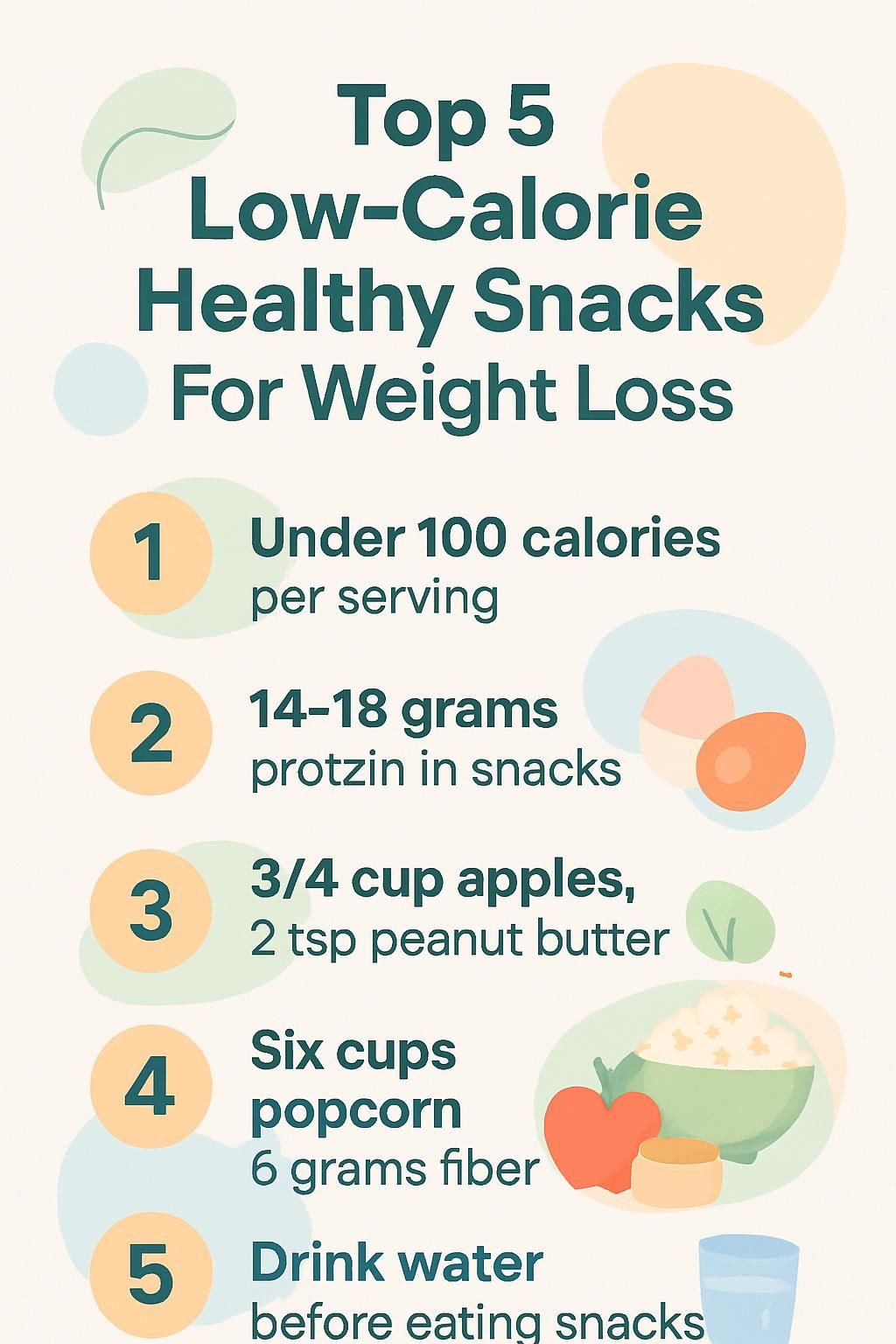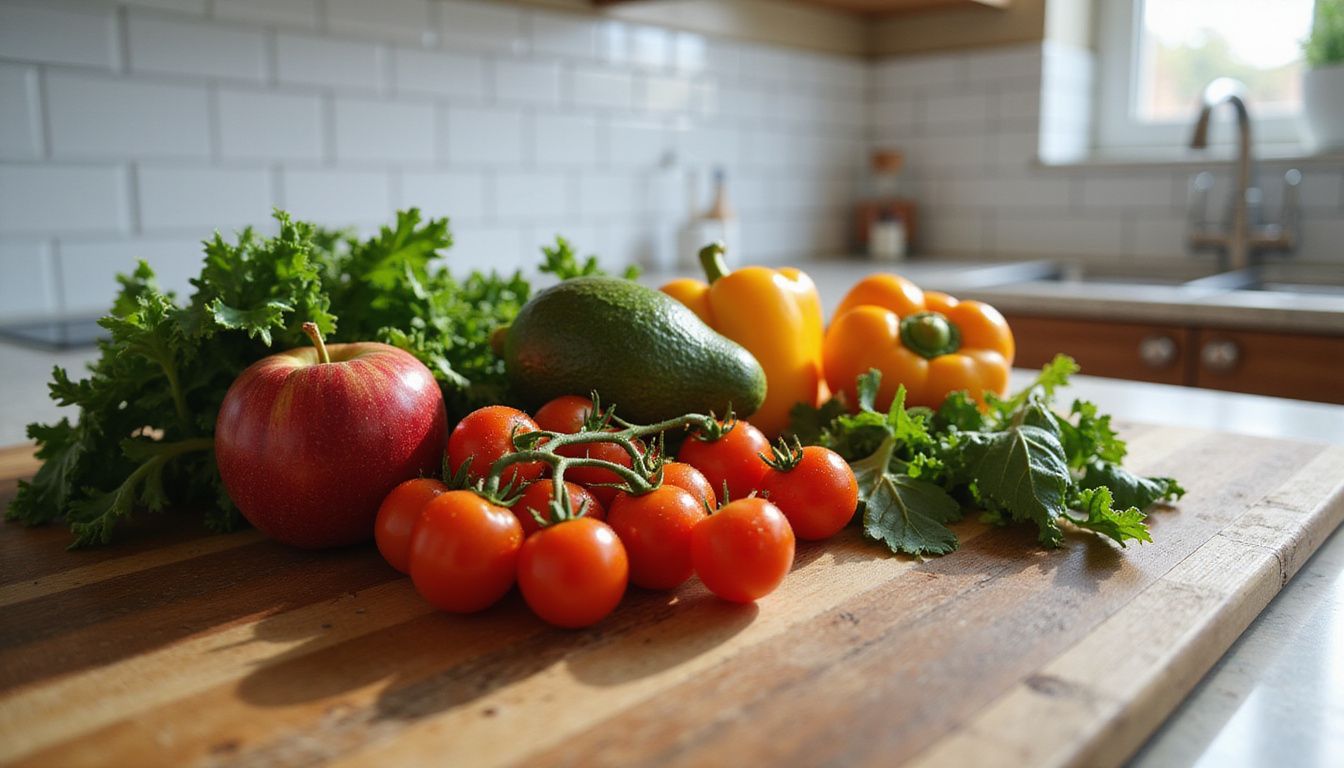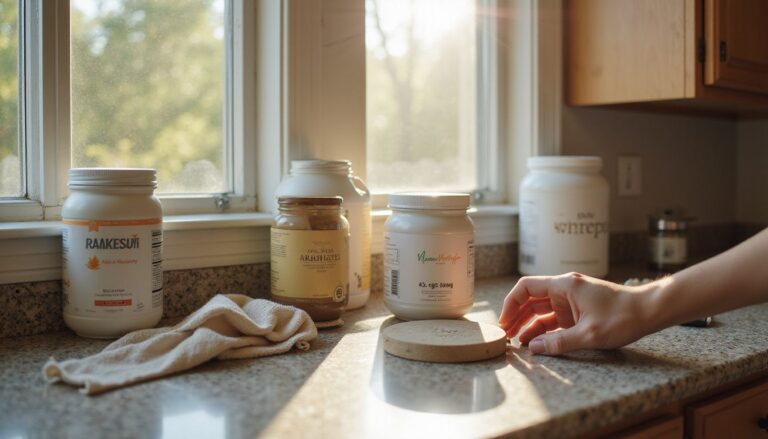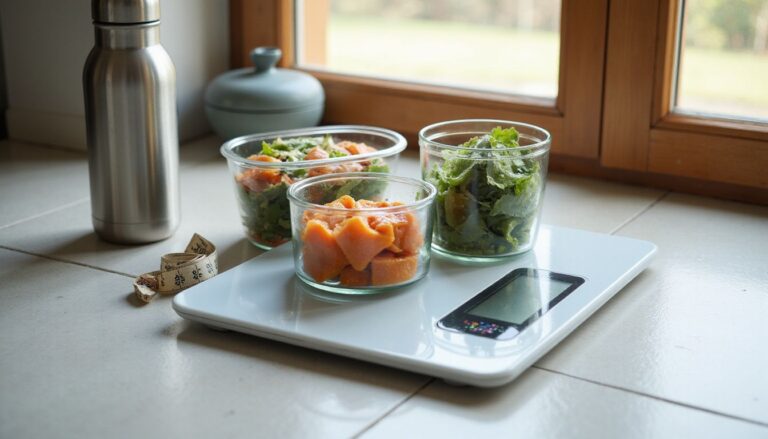Top 5 Low-Calorie Healthy Snacks For Weight Loss
Our Nutrition Assistant AI Suite will transform your body. You will lose fat, get toned, and build muscle. Gain confidence and optimal health.
If you feel hungry between meals while trying to lose weight, you are not alone. Choosing healthy snacks for weight loss can steady your appetite, support energy, and make your plan easier to follow.
Below you will find five low-calorie snack ideas that taste great and fit a healthy diet. Use them to stay full between meals without adding many calories.
Key Takeaways
- Pick low-calorie options such as Greek yogurt with berries or celery with hummus. These provide protein and fiber, and most servings can fit under 100 calories.
- High protein snacks help you feel full longer. Examples include cottage cheese, about 14 grams protein per half cup, and edamame, about 18 grams per cup.
- Portion control matters. A simple example is 3/4 cup apple plus 2 teaspoons peanut butter, about 90 calories, which curbs hunger without overeating.
- Air-popped popcorn gives you whole grains and roughly 6 grams of fiber in six cups for about 100 calories, a heart-friendly pick.
- Mindful habits, like drinking water before snacking and limiting added sugars, support healthy weight according to Harvard Health guidance from 2022.

Benefits of Low-Calorie Snacks for Weight Loss

Low-calorie snacks can help you manage hunger between meals. The right choices give you important nutrients while keeping calories in check.
How do low-calorie snacks help control hunger?
Snacks that are low in calories but rich in protein and fiber help you stay satisfied. Protein is a building block for muscles and slows digestion, so you feel full longer. For example, cottage cheese offers about 25 grams of protein per cup.
Fiber, the part of plants that aids digestion, fills your stomach and steadies blood sugar. Edamame contains about 18 grams of protein and 8 grams of fiber per cup, a combo that fights cravings.
Picking nutrient-dense snacks prevents energy crashes that push you to overeat. A bowl of Greek yogurt with mixed berries has kept me full until dinner many times, without blowing my calorie budget.
Choosing smart, light snacks makes hunger easier to manage while supporting your healthy weight goals.
How do low-calorie snacks improve nutrient intake?
Low-calorie snacks are a simple way to boost daily nutrients. Fruits and vegetables raise your intake of fiber, vitamins, and minerals many people lack.
Bell pepper strips with guacamole deliver antioxidants and healthy fats in one bite. Chia pudding adds fiber, plant protein, and omega-3 fats, which support heart and brain health.
On busy days, apple slices with peanut butter or cottage cheese with fruit add vitamin C, calcium, and potassium. Greek yogurt with berries is another quick pick that supplies protein and antioxidants.
Swapping chips or cookies for whole grain crackers or hummus lowers added sugar and raises nutrient quality, which supports weight management.
How do low-calorie snacks support sustainable weight loss?
Low-calorie snacks that are rich in nutrients help cut extra calories while keeping you satisfied. Picks like Greek strained yogurt, cherry tomatoes, or whole grain crackers fit easily into a balanced plan.
Replacing highly processed foods with beans, fresh fruit, or nuts gives steady energy and supports a plant-forward diet. Pair smarter snacks with portion control for the best results.
Research links a modest calorie deficit to lower risk of heart disease and type 2 diabetes over time. Dietitians often suggest aiming for snacks near 100 calories that deliver flavor and fullness, which helps you stay consistent.
How to Choose Healthy Snacks for Weight Loss
Smart snack choices can support fat loss and steady energy. Focus on nutrient-dense foods such as fruit, legumes, or oatmeal so you can stay on track without losing taste.
What are the best high-protein and high-fiber snack options?
Protein and fiber help you feel full, keep energy stable, and support weight goals.
- Hard-boiled eggs give about 6 grams of protein each plus vitamin A. Enjoy one or two as a quick snack.
- Edamame, young soybeans, provide about 18 grams protein and 8 grams fiber per cup, with little saturated fat.
- Greek yogurt with berries has around 12 grams protein per half cup of yogurt and about 84 calories. Berries add antioxidants.
- Roasted chickpeas offer fiber and plant protein. Season with garlic powder or spices for savory flavor.
- Cottage cheese with fruit supplies protein, calcium, and vitamins with modest fat. It keeps you satisfied.
- Apple slices with a tablespoon of peanut butter bring fiber and healthy fats in roughly 100 calories.
- Air-popped popcorn delivers crunch and fiber with few calories when served plain. Add cinnamon or a light sprinkle of salt if needed.
- Carrot sticks with hummus add vitamins and plant protein from chickpeas.
- Oatmeal made with milk gives complex carbs, some healthy fat, and protein. Banana slices add potassium.
- Trail mix with a few dark chocolate chips, almonds, and dried fruit adds healthy fats, fiber, and minerals.
These snacks control hunger while delivering nutrients from fruits, legumes, nuts, dairy, oats, and vegetables.
Why should you avoid added sugars and processed ingredients?
Processed snacks can be high in calories and low in nutrition. Many contain refined flour, added sugar, and unhealthy oils, so they do not keep you full.
They may taste good at first but can lead to overeating and weight gain. Some processed items may also raise LDL cholesterol, a risk factor for heart disease.
Peanut butter with only peanuts and salt gives healthy fats without extra sugar. When I switched to a simple ingredient peanut butter, I felt satisfied longer and found it easier to meet my goals.
Most experts agree that whole foods, like berries, almonds, Greek yogurt, cottage cheese, hummus, salad vegetables, and air-popped popcorn, offer more nutrients and fewer empty calories.
How can portion control improve snack choices?
Portion control prevents overeating, even with healthy snacks. A 1 ounce, about 1/4 cup, serving of mixed nuts gives benefits without too many calories.
Choosing 14 almonds keeps the snack under 100 calories, which supports calorie restriction and weight loss. Measuring servings for popcorn or carrots with hummus keeps intake in check.
Three cups of air-popped popcorn have fewer than 100 calories. Eight baby carrots with hummus also stay under that mark. Clear portions support mindful eating and help you avoid snacking at night.
Greek Yogurt with Mixed Berries
Greek yogurt with mixed berries is a quick, protein-rich snack that also supplies calcium. It works well for breakfast or an afternoon break.
Why is Greek yogurt with mixed berries a healthy snack?
Greek yogurt with berries delivers protein and calcium in a low-calorie package. A half cup of plain Greek yogurt with a touch of honey has about 12 grams of protein, which supports lean muscle during weight loss.
Blueberries and strawberries add antioxidants, which protect your cells. Fiber in the fruit helps you feel full, so you avoid sugary snacks or refined grains.
When I need a fast breakfast, I reach for Greek yogurt and fresh berries. It satisfies my sweet tooth and keeps my energy steady all morning.
What is the nutritional value of Greek yogurt with berries?
Understanding the nutrition helps you see how this snack fits your plan.
| Ingredient | Serving Size | Calories | Protein (g) | Saturated Fat (g) | Sodium (mg) | Cholesterol (mg) |
|---|---|---|---|---|---|---|
| Nonfat Greek Yogurt with Honey | 1/2 cup + 1 tsp | 84 | 12 | 0 | 53.5 | 0 |
| Nonfat Yogurt with Frozen Blueberries | 1/3 cup yogurt + 2/3 cup blueberries | 100 | Not specified | 0 | 59 | 2 |
- High protein helps control hunger and supports muscles.
- Zero saturated fat keeps the snack heart-friendly.
- Low sodium suits a heart-healthy diet.
- Minimal cholesterol supports heart health goals.
- Fruit adds fiber, vitamins, and antioxidants.
How can I prepare Greek yogurt with berries quickly?
You can assemble this snack in minutes with simple steps.
- Scoop one cup of nonfat Greek yogurt into a bowl for a high-protein base.
- Add half a cup of fresh or frozen mixed berries, such as strawberries, blueberries, or raspberries.
- Drizzle one teaspoon of honey for light sweetness if desired.
- Stir gently so the yogurt and berries combine evenly.
- Blend with ice for a quick smoothie on busy mornings.
- Sprinkle a small amount of crushed nuts, such as almonds, or a few dark chocolate pieces for crunch and flavor.
- Serve right away for the best texture and taste.
This method takes less than five minutes and keeps me full longer than crackers or other processed snacks.
Apple Slices with Peanut Butter
Apple slices with peanut butter are quick to prepare and rich in fiber and protein. This duo helps control hunger as part of a balanced diet.
Why are apple slices with peanut butter good for weight loss?
Apples provide fiber, which fills you up, while peanut butter adds healthy fats and protein that slow digestion. Together they support steady energy and fewer cravings.
Research shows that combining fiber and protein can reduce calories eaten at the next meal. Mindful portions make this snack fit daily goals without stalling progress.
What nutrients are in apple slices with peanut butter?
This snack delivers fiber, vitamins, healthy fats, and protein in about 90 calories per serving, 3/4 cup apple plus 2 teaspoons unsalted peanut butter.
| Nutrient | Source | Amount per Serving | Health Benefit |
|---|---|---|---|
| Calories | Apple + Peanut Butter | ~90 kcal | Low calorie supports weight loss |
| Fiber | Apple | 2-3 grams | Promotes fullness and gut health |
| Vitamin C | Apple | 4.6 mg | Supports immune function and skin |
| Healthy Fats | Peanut Butter | About 2 grams | Improves satiety and heart health |
| Protein | Peanut Butter | ~2 grams | Helps muscle maintenance and appetite control |
| Sodium | Apple + Unsalted Peanut Butter | 2 mg | Low sodium supports blood pressure |
| Saturated Fat | Peanut Butter | 0.8 grams | Within heart-healthy limits |
| Cholesterol | Apple + Peanut Butter | 0 mg | Cholesterol free |
This combo gives steady energy without blood sugar spikes. Having apple slices with peanut butter has often stopped my late afternoon cravings and kept me satisfied until dinner.
What is the recommended portion size for this snack?
Measure 3/4 cup of apple slices and 2 teaspoons of unsalted peanut butter. This serving totals about 90 calories and balances fiber, fat, and protein.
Use measuring cups or a food scale to avoid overeating, especially when snacking while working or watching TV. Prepping single portions ahead of time makes healthy choices easier when cravings hit.
Celery Sticks with Hummus
Celery sticks with hummus make a crunchy, filling snack that supports weight goals. For variety, you can pair this snack with a few almonds or a small serving of whole-grain crackers.
Why choose celery sticks with hummus as a snack?
Celery with hummus delivers volume for few calories. Hummus adds plant protein and healthy fats, which help you feel satisfied longer.
Six medium celery stalks with two tablespoons of hummus fit most low-calorie plans. The combo is nutrient dense and low in added sugars or refined ingredients.
What is the nutritional profile of celery sticks with hummus?
Here is a typical nutrition breakdown for one cup of celery sticks with two tablespoons of hummus.
| Nutrient | Celery Sticks (1 cup, approx. 101g) | Hummus (2 tbsp, approx. 34g) | Total per Serving |
|---|---|---|---|
| Calories | 16 | 70-80 | 86-96 |
| Protein (g) | 0.7 | 2 | 2.7 |
| Fat (g) | 0.2 | 5 | 5.2 |
| Saturated Fat (g) | 0 | 0.4 | 0.4 |
| Carbohydrates (g) | 3 | 4 | 7 |
| Fiber (g) | 1.6 | 1.5 | 3.1 |
| Sodium (mg) | 80 | 210 | 290 |
| Cholesterol (mg) | 0 | 0 | 0 |
- Under 100 calories per serving.
- About 3.1 grams of fiber to help keep you full.
- Very low saturated fat and zero cholesterol.
- Sodium is 290 mg per serving, so choose lower sodium hummus if needed.
As someone who loves crunchy foods, celery and hummus help me manage afternoon hunger without excess calories. The texture is satisfying and the fiber keeps me on track.
What are easy ways to prepare celery sticks with hummus?
Quick preparation makes this snack easy to fit into your day.
- Wash celery under cold water to remove dirt or residue.
- Cut stalks into 3 to 4 inch sticks for easy dipping.
- Measure 2 tablespoons of hummus per serving to control calories.
- Arrange celery on a plate and place hummus in a small bowl.
- Rotate in carrots or cucumber slices for variety.
- Dust hummus with paprika or black pepper for extra flavor.
- Store extra sticks in water in the fridge to keep them crisp for up to three days.
- Add a few whole grain crackers or turkey slices for extra protein if needed.
- Pair with cottage cheese or ricotta for more protein and calcium.
- Eat slowly and sip water to boost fullness.
Air-Popped Popcorn
Air-popped popcorn is a smart, low-calorie way to satisfy a craving for something crunchy. It is simple to prepare and easy to season.
Why is air-popped popcorn a healthy low-calorie snack?
Air-popped popcorn gives you volume for very few calories. A three-cup serving comes in under 100 calories and does not require oil or butter.
Popcorn is a whole grain, which means it retains fiber and micronutrients. When I switched to popcorn instead of flavored crackers, my afternoon appetite felt easier to manage.
What nutrients does air-popped popcorn provide?
Six cups of air-popped popcorn contain about 100 calories and roughly 6 grams of dietary fiber. Fiber supports digestion and helps you feel full between meals.
Saturated fat is very low if you skip butter. Sodium stays low when you do not add salt. You also get small amounts of minerals like magnesium and phosphorus.
How can I add flavor without extra calories?
Seasoning brings big flavor without piling on calories.
- Sprinkle nutritional yeast on popcorn for a cheesy, savory taste.
- Use spices such as smoked paprika, chili powder, or cinnamon.
- Add a light drizzle of olive oil spray to roasted vegetables for richness.
- Squeeze lemon juice over apple slices or cottage cheese to brighten flavor.
- Grate a small amount of Parmesan over popcorn, about a tablespoon.
- Stir black pepper and garlic powder into hummus.
- Mix in fresh herbs like parsley, basil, or chives with Greek yogurt.
- Serve salsa with raw vegetables like carrots and celery for a low-calorie dip.
Dialing up flavor makes healthy snacking enjoyable and easier to sustain.
Cottage Cheese with Fresh Fruit
Cottage cheese with fruit is simple, filling, and nutrient rich. Fruit adds fiber and vitamins that support your healthy diet.
Why is cottage cheese with fresh fruit a good snack choice?
Cottage cheese offers a strong balance of protein and relatively few calories. Protein and calcium support fullness and bone health.
Fresh fruit adds natural sweetness and important micronutrients. This mix provides quick energy from fruit sugars plus lasting satiety from dairy protein. Many athletes like this snack for recovery.
What is the nutritional benefit of cottage cheese with fruit?
Half a cup of cottage cheese mixed with cantaloupe has about 100 calories and 14 grams of protein. That much protein can help reduce cravings between meals.
Cottage cheese also supplies calcium. Fruit adds fiber and vitamins A and C. Together they form a balanced snack that is more filling than many processed options.
Which fruits pair best with cottage cheese?
Many fruits work well, so you can rotate flavors and nutrients.
- Pineapple, sweet and juicy, with vitamin C and manganese.
- Watermelon, hydrating and low in calories.
- Cantaloupe, rich in vitamin A for eye health.
- Strawberries, high in vitamin C and low in calories.
- Blueberries, add fiber and support heart health.
- Peaches, creamy and sweet with potassium.
- Bananas, smooth and rich in potassium.
- Kiwi, tangy with vitamin C and fiber.
- Apples, crunchy and filling.
- Mango, tropical flavor with vitamins A and C plus folate.
Rotating fruits keeps your snack interesting and broadens your nutrient intake.
Tips for Snacking Mindfully
Eating mindfully helps you enjoy snacks like fruit, yogurt, or popcorn without overeating. A few simple habits can make a big difference.
How can I avoid emotional eating when snacking?
Plan snacks in advance to reduce impulse eating. Keep options like Greek yogurt, fresh fruit, or cottage cheese ready, instead of grabbing food in response to stress or boredom.
Notice patterns. If stress triggers cravings, drink water first since thirst can mimic hunger. Research from Harvard Health in 2022 notes that mindful snacking can reduce overeating. Choose nutrient-dense options so smaller portions feel satisfying.
Why is portion size important for mindful snacking?
Proper portions keep calories in control. Many low-calorie snacks are easy to pre-measure, such as 14 almonds, 8 baby carrots, or 3/4 cup apple with 2 teaspoons peanut butter.
Single-serve cups of Greek yogurt also help. Taking one serving of crackers, rather than eating from the box, prevents accidental overeating. Measuring snacks before sitting down helped me eat less and feel satisfied longer.
How does drinking water improve snack time?
Drinking water before or with a snack can help you feel full sooner. Many people confuse thirst with hunger, which can lead to extra calories.
Hydration also supports digestion and nutrient use. Start snack time with a cup of water to encourage fullness and steadier portions.
Frequently Asked Questions About Healthy Snacking
Here are answers to common questions so you can put these ideas to work.
Are low-calorie snacks effective for weight loss?
Yes. Low-calorie snacks can lower daily calorie intake and reduce hunger. Picking high protein or high fiber foods makes it easier to avoid overeating later.
There is no single magic snack. Still, replacing chips with apple slices and peanut butter or choosing Greek yogurt with berries supports better eating patterns. Many people report better satiety during the day with these swaps.
How many snacks should I eat daily for weight loss?
Most adults do well with two to three planned snacks per day. This pattern balances convenience, energy, and hunger control.
Needs vary based on activity and appetite. Choose nutrient-dense options to meet energy needs without excess calories. One source from the Academy of Nutrition and Dietetics notes that planned, protein or fiber rich snacks can improve appetite control [1].
References:
[1] Academy of Nutrition and Dietetics, “Snacking Sense,” EatRight.org (2020).
When is the best time to eat snacks during the day?
Timing matters. Having a snack two to three hours after a meal can steady blood sugar and prevent overeating at the next meal.
Many people like a mid-morning snack around 10 a.m. or an afternoon snack around 3 p.m. I used to fade in late afternoon until I added fruit with cottage cheese at 3:30 p.m. It kept hunger controlled and made my workout easier.
This article provides general information. For personal advice, speak with a registered dietitian or your healthcare professional.
Conclusion
You have many tasty options to reduce hunger while losing weight. Greek yogurt with berries, apple slices with peanut butter, celery sticks with hummus, air-popped popcorn, and cottage cheese with fruit are simple, satisfying, and low in calories.
Each snack is easy to prep and full of nutrients that help keep you full between meals. Choosing whole foods and paying attention to portions can help you stay on track with your healthy weight goals.

FAQs
1. What are the top five low-calorie healthy snacks for weight loss?
The best options include Greek yogurt with berries, raw vegetables with hummus, air-popped popcorn, cottage cheese with sliced fruit, and roasted chickpeas. These choices offer high protein or fiber content that helps you feel full while keeping calorie intake low.
2. How many calories do these snacks usually contain?
Most of these snacks provide between 80 and 150 calories per serving. For example, one cup of Greek yogurt with half a cup of berries contains about 120 calories; a cup of raw carrots with two tablespoons of hummus has around 100 calories; three cups of air-popped popcorn have about 90 calories; half a cup of cottage cheese with pineapple is roughly 110 calories; and half a cup of roasted chickpeas offers close to 130 calories (USDA FoodData Central).
3. Are these snacks supported by research for weight management?
Yes, studies show that foods rich in protein or fiber can help control hunger and support weight loss efforts (Rolls et al., American Journal of Clinical Nutrition). Choosing nutrient-dense foods like dairy products or legumes may improve satiety compared to processed snack items.
4. Can I eat these snacks daily as part of my diet plan?
You can include these healthy options each day if you monitor portion sizes and total calorie intake. In my experience working toward healthier eating habits, swapping chips for vegetables with hummus made it easier to manage cravings without feeling deprived.
Summary: Selecting low-calorie nutritious snacks such as yogurt, fresh produce paired with dips, whole grains like popcorn, dairy-based options like cottage cheese mixed with fruit pieces, or plant-based proteins such as chickpeas supports effective weight management when combined into an overall balanced meal plan.






